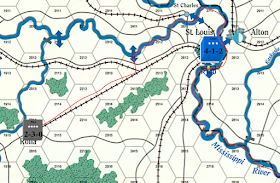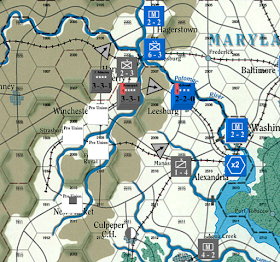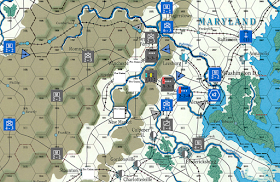At the very start Illinois militia occupy Cairo. They have been told to fortify, but have no engineers (need an Infantry strength factor - subtle change from previous game, as is the free deployment for some of the militia).
The Union build 50 garrison, 2 cavalry, and 12 militia factors, a railroad repair unit, a naval flotilla, an ironclad, 3 river flotillas, a river transport and convert 6 militia to one 4 factor infantry division and a 2 factor brigade. They are left with 81 supply points.
The Confederate build 21 militia and 21 garrison factors, convert 14 militia to 4 three factor infantry divisions and a two factor brigade, augment two 3 factor divisions to 10 factor divisions (this is a correction to previously posted one augmented division) and a 2 factor cavalry division to a 5 factor cavalry division. They had plans to build a railroad repair unit and the CSS Merrimack, but thought it best to husband their remaining 131 supplies.
For reinforcements the Union received 10 militia factors and the Confederates 8. The more flexible deployment will assist both sides.
The Confederates undergo some brigade merges within Johnson and Beauregard's armies giving them a bit more coordination of their respective troops. The Union hear word of an intended attack on Alexandria and in the first die roll of the game spend 50 supply points and successfully construct a fort which the half strength division occupies. Prior to doing this they had worked out with their commissary officers how much supply was required by the Union troops - 19 (the benefits of having a fixed Supply Consumption Table).
The Union establish a Department at Washington. Neither side is able to create an Army HQ (the rolls are noted and with the new Random Selection without Replacement Variant rule, they are one step closer to getting a HQ. The Confederates get two Generals, Hardee who goes to Memphis, TN, and Van Dorn who goes to Charleston, SC.
Next is supply consumption which we noted already for the Union is 19.
Then the new rules for Missouri and Kentucky come into play.
The Union control St Louis and Jefferson City,
the Confederates Springfield, Rolla and New Madrid.
Militia roll for Missouri was Hannibal which is currently neutral, so no militia placement this cycle. Kentucky saw militia raised for the Union in Louisville and Frankfort (luckily the Union had the required spare counters to make these placements).
These two new Kentucky Militia will need supply,
but in the next Strategic Cycle.
Confederate supply was 20 using 7 railway. The only tricky one was Rolla which was a combination of rail and water. Eight other supply were delivered by water and the Union will be able to cut most of these.
Being able to supply Price in Rolla required use of the neutral Missouri railway linking up with water transport on the Mississippi. General Lyon was heard to say "Let's see him try that again!"
First Week
The Confederates have the 2 chit and the Union the... 3!McClellan is sent to Richmond, IN, to collect some militia. Militia from St Louis was sent via Jefferson City to Ironton, the purpose of this circuitous route being to establish a railhead at Jefferson City and at the ferry hex that the Confederates had used to supply Rolla. McDowell and four divisions cross the Potomac and seize Leesburg.
One naval flotilla is sent to sit off the coast at Brunswick, GA, blocking the coastal route connecting the Confederate seaports of Fernandia and Jacksonville. The other one with Porter sets sail for Baltimore.
Lyons sends another militia unit to occupy St Joseph, establishing a railhead at Macon City.
The Union deploy extra militia to Washington, DC, Hagerstown, MD and Alton, IL.
The Confederates react, sending both Johnston and Beauregard to attack the Union troops at Harper's Ferry.
Van Horn thinks about going to Fort Sumter, Price thinks about retreating to Springfield, MO, Polk sails to Little Rock and Hardee thinks about going to Union City.
Beauregard attacks, Johnston doesn't. The attack is on the 131 to 160 column of CRT 0 with Beauregard leading the attack. The Union avoid expending supplies, but much to Beauregard's annoyance his troops load up on ammunition. The result is what he wanted, with the Union withdrawing from this strategic location. No losses occurred.
The triangles with the arrows denote the end of infrastructure friendly to the Confederates,
the significance being that even if the Union get the 3 chit again,
they would not be able to sweep around behind the Confederates.
The Confederates call up militia in Memphis, TN, Little Rock, AR, and Richmond, VA.
Second Week
The Confederates get a double move (as they had hoped for) when the Union draws the 0 chit.Beauregard dispatches a brigade towards Grafton, orders the brigade at Harper's Ferry to cut the rail line and then moves back to cover Manassas. Johnston moves to cover Harper's Ferry. The Confederates believe they have little to fear from the Union.
Van Horn goes to Fort Sumter to review the two divisions based there, Price continues to think about retreating to Springfield, MO, Polk sets sail for New Madrid, MO, with some militia and a supply train (he gets as far as Memphis) and Hardee continues to think about going to Union City.
McDowell considers his options. McClellan has opinions, but takes no action. Butler sits put (he's a bit of a problem and I'm not sure what I'm going to do with him). Lyon is raring to go, but doesn't yet have the capacity to do anything, plus he needs to protect St Louis. The Governor of West Virginia calls out the militia to protect Grafton.
Third Week
The Union again draw the zero chit.The Grafton raiding force contents itself with cutting the railway line and then pulling back to Romney. Hardee is given a direct order and force marches to Union City, or rather he has his supply train railed there and directs his army to the buffs at Island No. 10, which he decides is the perfect place for a fort.
Lyon faces off Price, Polk and Hardee for Missouri.
Polk arrives at New Madrid. Price stays put. Van Horn brings the two infantry divisions back from Fort Sumter to Charleston, SC. The last of this month's militia are posted to Richmond.
Feeling confident, Johnston and Beauregard hold their positions, awaiting a Union attack...
McDowell does a forced march to Manassas Junction, the Confederate cavalry falling back before the Northern aggressors. The force march costs him 20% casualties which is 6SPs - OUCH!
McClellan collects up militia and returns to Cincinnati. Butler says if you want him to do anything send him some transport (he kind of has a point). Lyon rails his cavalry to Hannibal to take possession of that town for the Union.
McDowell attacks the cavalry screen, which retreats permitting the Union to increase their encirclement and isolation of the Confederates in the Shenandoah Valley.
The Union bloody victory at Manassas has created a huge problem for Johnston and Beauregard.
As New Market is not friendly that can't use it to trace a Supply Path and therefore start off isolated.
They should have been attending to that rather than sitting about waiting to be attacked.
Fourth Week
The Union have one initiative this week. This means they will be going last, which further puts pressure on the Confederates.
Johnston is activated and sends a brigade to New Market which restores the lines of supply and hence communication for some of the Confederate force. He moves with his remaining two divisions to join Beauregard and plot their revenge.
Price is ordered to pull back to Springfield, MO, which he reluctantly does, hanging on the outskirts of Rolla.
Polk and Hardee sit tight. McGruder thinks about returning to Richmond, but doesn't. Van Dorn takes the train to Mobile to establish a command for the Gulf.
Beauregard with five divisions attacks McDowell's three. The odds are in the 161 to 200 column of CRT 3. The Union consume supply while the Confederates don't. Is this a sign? The die roll is a 2 which Van Dorn can adjust up or down by one which means he can go to 1, take a few more casualties and force the Union to retreat. Losses were 3 for the Confederates and 2 for the Union.
Beauregard has turned the tables, but now it is over to McDowell.
McDowell pulls back the exposed 7-3 division to his stack and remains in place blocking Beauregard's supply path. However he does take precautions to clear the two hexes around the bridge that crosses between C2510 and C2511. Unfortunately this costs him another strength point due to the the need to force march.
McClellan attends to training the militia and Lyon hopes for more troops to defend St Louis.
The remaining militia on both sides are deployed to their capitals.
Casualties
For the first "month" of the war losses were 3 for the Confederates against 9 for the Union. 7 of those Union losses were due to forced marches. McDowell should have considered using some of his supplies to reduce the risk of loss due to forced march.










Already a very different game
ReplyDeleteand McDowell so active, he must have had his vitamins,
though his troops had soon better learn to march!
Yes, amazingly different given the rather simple changes. Not having automatic use of bridges is significant, particularly in the east and the absence of lots of ZoCs also changes play as does the increased focus on supply.
DeleteAs to McDowell...
Further analysis of the Union force march disaster – they should have moved one unit first to convert the hexes to friendly. Duh! Worse, they also took losses to a division that reduced it to a brigade which means that cannot use the augmentation process to save personnel points to rebuild it. Double doh!!